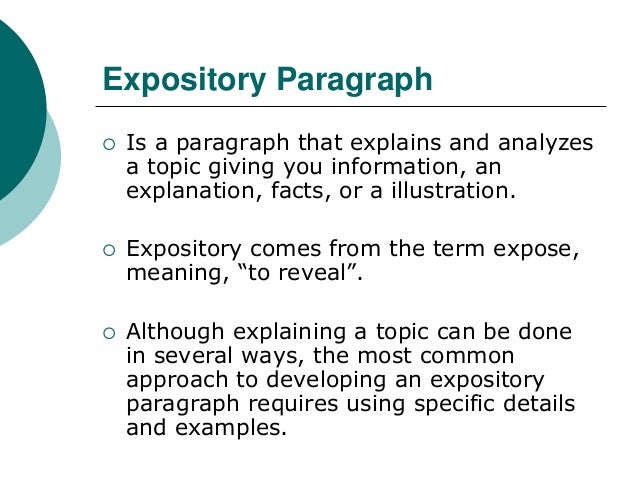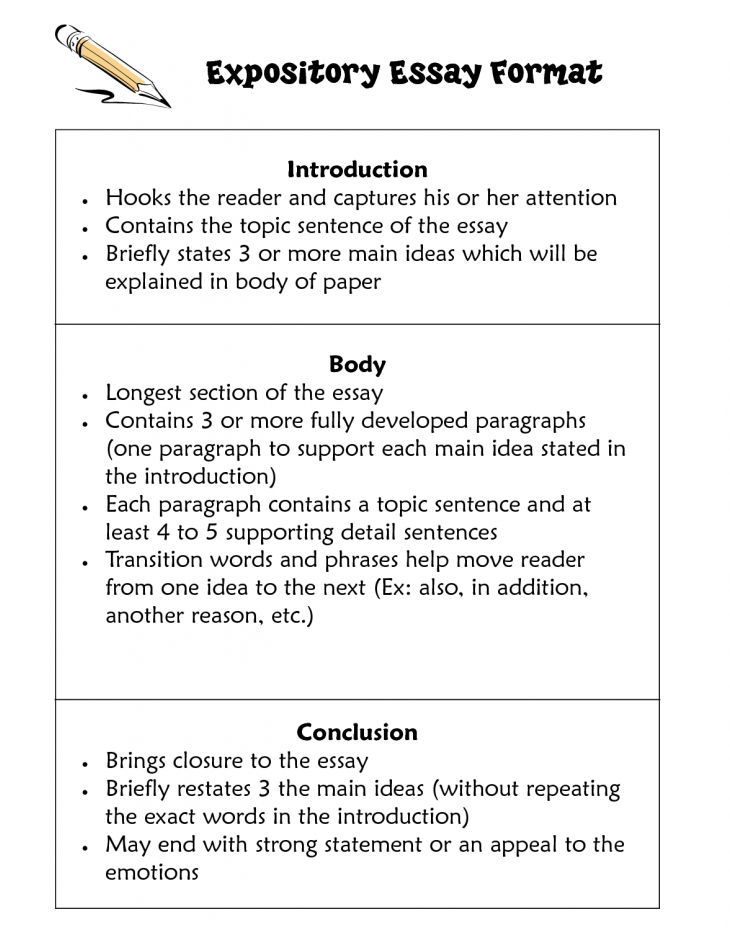Expository -- Informative Writing
In an expository paragraph, you give information. You explain a subject, give directions, or show how something happens. In expository writing, linking words like first, second, then, and finally are usually used to help readers follow the ideas. This paragraph, like any other, organizes itself around three parts.


Things to use when writing an expository paragraph:
Use Facts
Give Clear Directions
Steps--Make sure that steps are easy to follow
Time Order--What comes first, second, third, etc.
Expository writing is a mode of writing in which the purpose of the author is to inform, explain, or define his or her subject to the reader in a clear and logical way.
Some Things that a writer should consider doing when writing an expository paragraph:
1. Follow order
2. Be logical
3. Endeavor to explain Using Clear and Concise Language
4. Problem/Solution--State the problem and then offer a solution to that problem.
5. Compare and Contrast. Write about the smiliarties and the differences of two or more things.
Example One

Going to college can be expensive. First, college tuition and room and board can cost anywhere from $2,000 to more than $10,000 per semester. Other expenses make going to college even more expensive. For example, books typically cost between $100 and $500 each term. Second, materials are also very expensive. Paper, notebooks, writing utensils, and other supplies required often cost more at the college bookstore than at any local discount department store. For instance, a package of notepaper costing $2 at a discount store might cost $5 at a college bookstore. Finally, there are all kinds of special fees added onto the bill at registration time. A college student might have to pay a $50 insurance fee, a
$20 activity fee, a $15 fee to the student government association and anywhere from $500 to $100 for parking. There is another fee if a student decides to add or drop classes after registration. The fees required to attend college never seem to end.
Example Two
Three Types of Planets People often think all planets are alike, but there are actually three types of planets in the solar system. The terrestrial planets are made of rock and metal and are closest to the sun. These include the midsize planets Mercury, Venus, Earth, and Mars. They rotate slowly and don’t have many moons. Farther from the sun are the planets called gas giants, Jupiter, Saturn, Uranus, and Neptune. They are called gas giants because they are formed from gases such as hydrogen and helium. Gas giants rotate fast and have many moons. Finally, planetoids are objects made up of rock and ice and are too small to be true “planets.” Planetoids sometimes even get pulled into a planet’s gravitational field and become moons themselves. Whether they are terrestrials, gas giants, or planetoids, the planets in the solar system are fascinating.
Example Three
There are many ways to make a sandwich. My personal favorite way to assembly a sandwich follows below. Follow my steps and you will be soon eating a wonderful thing. First, you must assemble your favorite bread, lunch meat, mayo, mustard, pickles, cheese, and onions. Second, you take two pieces of bread and and put mayo on both pieces. Third, you put a couple of layers of your favorite lunch meat on one slice of bread. Fourth, add a piece of cheese, some pickels, and the onion. Fifth, put the sandwich together. Sixth, pick it up and eat it. This is how I make a great sandwich.

The Cause and Lasting Effects of World War I
It’s almost impossible to imagine a war that involved 32 countries, 40 million fatalities, and 186 billion dollars. But World War I, also known as The Great War or The War to End All Wars, ended up being one of the costliest global conflicts in terms of both funds and human lives. While it’s difficult to understand the magnitude of World War I, it’s even harder to comprehend how the actions of Gavrilo Princip, a Bosnian assassin, could trigger such an international chain event.
Though there were many underlying causes to World War I, the events of June 28, 1914 are considered the inciting incident. Princip’s assassination of Archduke Franz Ferdinand and his wife Sophie in Sarajevo was designed to influence the creation of Yugoslavia. As a result, Austria-Hungary declared war on Serbia one month later during the July Crisis.
Though Serbia effectively accepted all of Austria’s demands except for one, the Austrian government broke diplomatic relations with the other country on July 25 and went ahead with military preparedness measures. (“Austria-Hungary declares war on Serbia,” History.com)
When Austria-Hungary entered the war, Germany was immediately involved. Serbia’s ally, Russia, posed a significant threat to Austria-Hungary’s objective. What could have been a small-scale skirmish turned into a larger operation when Germany then declared war on Russia.
His Majesty the Emperor, my august Sovereign, in the name of the German Empire, accepts the challenge, and considers himself at war with Russia.” (“The German Declaration of War on Russia,” wwi.lib.byu.edu/)
By bringing Russia to the war, Germany found itself at war with Russia’s ally, France. Soon after, Germany began “The Rape of Belgium,” in which it illegally invaded Belgium in an attempt to bring its troops to Paris. The atrocity quickly attracted international attention, including that of Britain, who declared war on Germany on August 4, 1914. Britain’s declaration of war is considered the true beginning of World War I. The assassination that caused the initial conflict was left behind long ago, as its effects were rapidly escalating long past that fateful day.
The effects of Princip’s actions quickly ricocheted around the world. The Ottoman Empire entered the war after making a secret alliance with Germany, and Montenegro and France declared war against Austria-Hungary. The Battle of the Marne in 1914 between Germany, France, Russia, and Britain began four years of constant trench warfare. Soldiers suffered from the advances of chemical warfare, as detailed by nurse Vera Brittain in her 1933 memoir Testament of Youth.
“I wish those people who talk about going on with this war whatever it costs could see the soldiers suffering from mustard gas poisoning. Great mustard-coloured blisters, blind eyes, all sticky and stuck together, always fighting for breath, with voices a mere whisper, saying that their throats are closing and they know they will choke.” (Brittain)
Operations continued in the Pacific as Japan, New Zealand, and South Africa declared war against Germany. Italy, having already proclaimed their neutrality, declared war on Germany after the Treaty of London. In 1917, Germany tried to coerce Mexico to declare war against America, leading President Woodrow Wilson to finally bring the United States into the strife.
But the right is more precious than peace, and we shall fight for the things which we have always carried nearest our hearts—democracy. . . . .” (Wilson)
Immediately following the United States’ entrance into the war was Cuba and Panama, who declared war on Germany the next day. Greece followed suit in June 1917, followed closely by Liberia and China. Over the next year, countless battles and operations pushed boundaries and lost hundreds of thousands of soldiers to the cause. The final offensive of World War I, the Hundred Days Offensive, led Germany to the brink of defeat. After Germany signed the Armistice of Compiègne on November 11, 1918, the fighting was officially over – but the effects of the war were just beginning.
World War I may seem like it took place over four very busy years, but the effects of the international strife would come to define the 21st century. By the time the Paris Peace Conference began in January 1919, Germany’s economy and morale had plummeted. They had fought against nearly 30 countries and had come close to complete destruction, only to feel cheated by the Versailles Treaty.
The social and economic upheaval that followed World War I gave rise to many radical right wing parties in Weimar Germany. The harsh provisions of the Treaty of Versailles led many in the general population to believe that Germany had been "stabbed in the back" by the "November criminals." (“WWI: Aftermath,” encyclopedia.ushmm.org/).
The discouraged nation was resistant to the provisions of the treaty and to their new democratic rule. Many German citizens longed for more authoritarian rule as they’d had prior to World War I. A ruined economy led to hyperinflation, which made Germany fearful of Communism as well. Adolf Hitler, an Austrian extremist and leader of the Nazi Party, became a welcome voice in right-wing nationalist politics.
Beyond Marxism he believed the greatest enemy of all to be the Jew, who was for Hitler the incarnation of evil. (“Rise To Power,” britannica.com)
Hitler’s leadership in the years following World War I was a direct result of the war’s events. The next global crisis, World War II, would result in atrocities far beyond the scope of its predecessor. The world would spend the second half of the 20th century recovering from the enormous costs of both of these wars.
One assassin on an ordinary day in 1914 ended up starting an unfathomable chain of events. The wars that resulted would define an entire century, several generations, and countless government actions. It’s important to consider the effects of any action, political or not, to decide whether it’s the best path to take.
The Assignment
Expository/Informative Paragraph Assignment
INSTRUCTIONS: You are to write TWO expository paragraphs (paragraphs that explain, give directions, etc.). Be sure to use logical order. Your goal is to get the reader to get from point A to point B without getting lost. Follow the paragraph recipe.
Paragraph One: Give directions from your house to the school.
Paragraph Two. Show the reader how to make your favorite sandwich.
"In teaching others, we teach ourselves" - Proverb
Have Fun!
The Team at Educator Pages